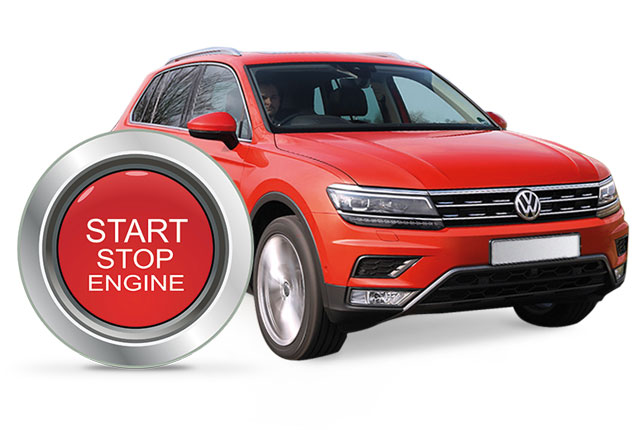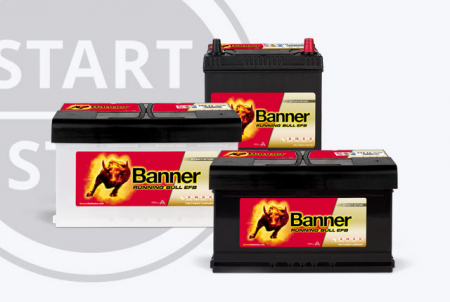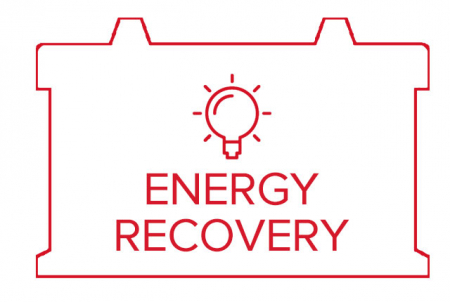START-STOP SYSTEM
START-STOP IS TOP, NOT A FLOP!
HOW DOES IT WORK?
More than 95 percent of all new cars are equipped with a start-stop function.
The start-stop technology saves fuel at every red traffic light, is easy on the wallet and is good for the environment.
We explain how it works and why it is so important that you select the right battery for this.
Because currently at least every second car that is brought to an garage is equipped with a start-stop system.
According to our research, about one in every third to fourth car brought to independent garages is equipped with a start-stop system.

Start-stop system to save the environment.
The aim of the automotive industry is to further reduce fuel consumption and, in doing so, reduce emissions. The target set by the EU is 95 g of CO2 per kilometre from 2020, which means that the majority of vehicles produced in Europe will be equipped with automatic start-stop systems or alternative drive systems. Already today, more than 95 percent of all new vehicles are equipped with a start-stop system in order to reach these fuel saving targets.
Vehicle manufacturers are making use of new battery technologies in the electrical system in order to:
- Enable the optimum charging current consumption from brake energy recovery (energy recovery).
- Ensure the optimum operating mode at lower levels of charge (SOC State Of Charge at approx. 70%).
- To guarantee a longer and stronger cyclic load at engine stop when the alternator is not charging.
How the start-stop system works
When the vehicle is stationary (e.g. at a red traffic light), the automatic start-stop function shuts down the engine and restarts it again automatically when you step on or off the clutch or brake during a stop. The result of this is that the start-stop system ensures lower fuel consumption – especially in city traffic. Due to the environmental factors and the improved economic advantage of this, the start-stop system is becoming more popular across all vehicle classes.
The savings potential: Depending on the driving situation, you can consume up to 0.8 l less fuel per 100 km, especially in city traffic. A start-stop system can reduce CO2 emissions by up to 8%.
The basic requirement is
a particularly strong and cycle-resistant start-stop battery.
Start-stop systems place higher demands on the car battery. Therefore, more power and higher cycle stability are required. When the vehicle is stationary, the battery must provide the energy for the increased number of engine starts and for the electrical loads in the car.
- AGM technology was specifically developed for vehicles with the highest energy requirements, brake energy recovery which are equipped with a start-stop system.
- EFB technology is used in vehicles with high energy requirements and simpler start-stop systems.
Good to know!
The first start-stop systems used on the market worked up to an ambient temperature of approx. +3 degrees Celsius, depending on the respective car manufacturer. The new start-stop technologies already work down to a temperature of approx. -5 to -10 degrees Celsius. The maximisation of the start-stop operating temperature further increases the demands on the start-stop battery!
Our start-stop batteries
Two different battery technologies (AGM and EFB) are used for vehicles with automatic start-stop systems:

for middle and upper class vehicles up to luxury class
- Valve regulated lead acid battery (VRLA)
- Triple cycle stability compared to conventional starter batteries: highest rating E4/M3 according to EN 50342-1
- Highest starting performance thanks to very low internal resistance
AGM = Absorbent Glass Mat, the acid is absorbed in a glass mat, meaning that it cannot leak.

for redundant safety systems and electric steering systems
- Valve regulated lead acid battery (VRLA)
- Triple cycle stability compared to conventional starter batteries; rating E4/M3 according to EN 50342-1
- Original equipment battery for Audi, BMW, Mercedes and Volvo
AGM = Absorbent Glass Mat, the acid is absorbed in a glass mat, meaning that it cannot leak.

for small cars up to upper middle class
- Glass coating on the separator and special active ingredient formula
- Cycle life that is twice as long as conventional starter batteries; classification E3/M2 according to EN 50342-1
- “Carbon loaded”: The carbon additives mean that the charging time is significantly reduced.
EFB = Enhanced Flooded Battery, the cycle-resistant starter battery.
The best-known start-stop technologies on Europe’s roads
Almost every car manufacturer has its own method for the engine’s automatic start-stop system. Here below is a short list of some of the best known start-stop systems:
- Bosch Stop & Start A reliable system that has been tried and tested millions of times over the years. Used in the VW Group (Audi, Porsche, Seat, Skoda, VW, etc.), BMW, FCA Fiat Chrysler Automobiles (Alfa Romeo, Fiat, Lancia, Maserati, Chrysler, Dodge, Jeep, RAM, etc.), as well as models of many other passenger car manufacturers. A stronger starter is necessary here, which is able to easily start several times. This system is managed by the higher-level engine control unit and is mainly determined by the following sensors: battery sensor, brake pedal sensor, speed sensor, clutch pedal sensor, crankshaft position sensor, etc. When the car stops, the engine is automatically switched off by the system. When the clutch is pressed down on a manual vehicle or the brake pedal is released on an automatic vehicle, the engine starts again. In more modern versions, the engine can also be switched off while driving, but only if the engine control unit gives the command to do so after estimating the speed of the car, making sure to check that the driver is not carrying out manoeuvres (accelerating, braking, cornering, steering, etc.) as well as checking for an incline or gradient in the road.
- Kia Motors ISG (Idle Stop & Go). In principle, this is identical to the Bosch system, but it also controls the alternator (generator) and switches off the engine. During acceleration, the system decouples the alternator and the entire load is on the battery. During braking, the alternator becomes active again and the battery is charged.
- Mazda SISS (Smart Idle Stop System), now known as i-STOP. Repeated engine starting is ensured here through forced fuel injection into the cylinders and igniting the air-fuel mixture. To achieve this, the engine control unit moves the pistons to the best middle position when braking so that they can be quickly restarted and started again. The starter is used only as additional energy source. A special feature from i-STOP: What’s new compared to the SISS is that the starting process is supported in the very first stage by an electric starter motor. This is not to be confused with i-ELOOP, which converts the energy generated when braking into electrical energy and stores it (= recuperation, braking energy recovery).
- Valeo i-StARS (Integrated Starter Alternator Reversible System). Used by the PSA Group (Citroën, DS, Peugeot), Mercedes-Benz and other car manufacturers. Own control unit and AC generator available, which combines the functionality of the starter motor (starter) and alternator (generator). A special drive belt with a newly developed tensioning device enables power transmission in both directions if required: starting the engine or charging the battery.
According to the manufacturer’s specifications, all systems can use the energy released when braking efficiently (= recuperation, braking energy recovery).
Banner tip: Please note that an integrated starter generator can usually recuperate higher electrical power than a belt-driven starter generator.

What does energy recovery mean?
Energy recovery is the same as brake energy recovery.
When you take your foot off the accelerator or press the brake pedal, some of the energy generated by this is recovered through the energy recovery process.
You might also be interested in the following

